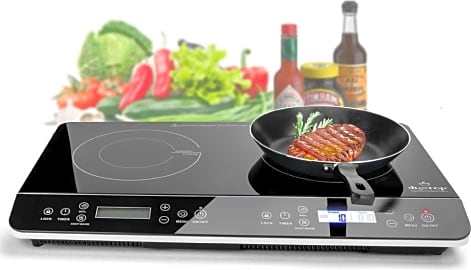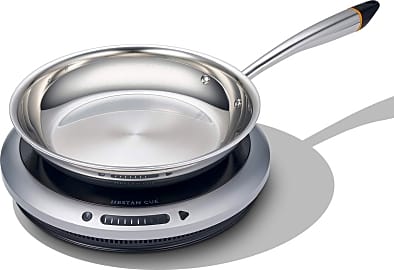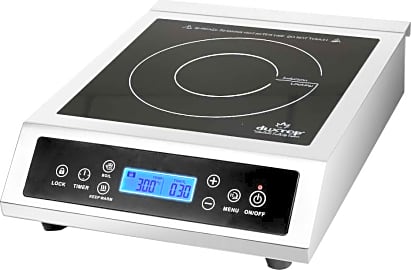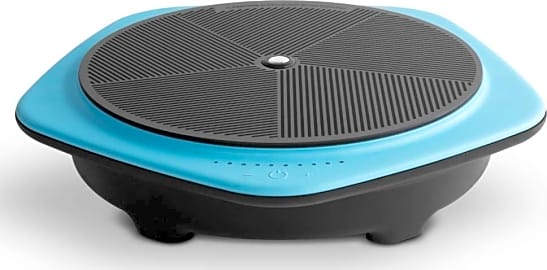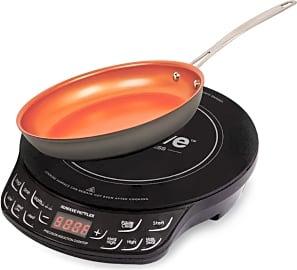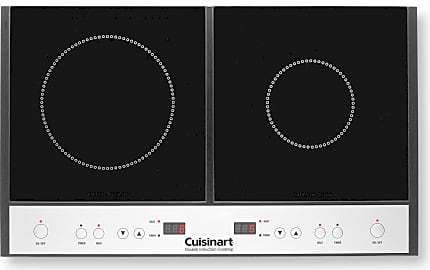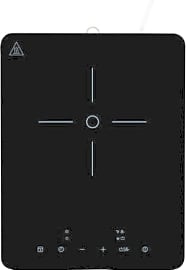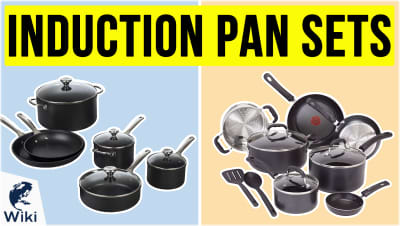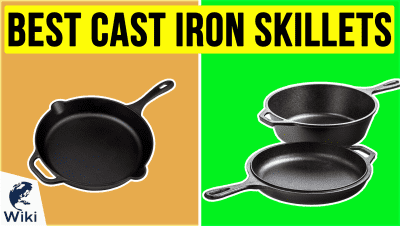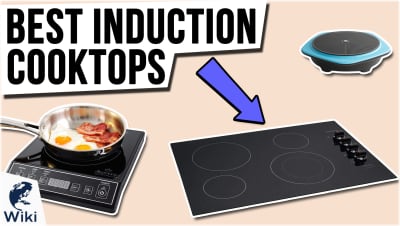The 10 Best Portable Induction Cooktops

This wiki has been updated 39 times since it was first published in September of 2016. Using high-powered magnets, rather than gas or radiant heat, portable induction cooktops aren't just ideal for providing a cooking station at an event, such as a party, fair, or cook-off; they can also be used as additional burners in the home for large gatherings of family and friends. They're fast, affordable, and economical, as they use up to 70 percent less power than a regular stovetop. When users buy our independently chosen editorial picks, we may earn commissions to help fund the Wiki.
Editor's Notes
October 29, 2020:
Whether setting up an outdoor kitchen for an event or simply cooking a large meal at home for a lot of guests, a portable induction burner can be a useful item. Not only do they give you an extra cooking surface, but they do so without the dangers of traditional cooktops. Of course, they do require the use of specific cookware, so make sure you have some induction-compatible pans before you go and a buy one of the models on this list. That being said, one of our new additions, the Hestan Cue Smart Gen 2, does actually come with a pan, as does the NuWave Flex.
Because Duxtop is known for making high-quality burners, we kept many of their models we previously recommended the last time we visited this list. There is one exception, however. Since the Duxtop 9600LS and Duxtop 9100MC are almost functionally the same, though the latter does lack some of the features the former has, we decided to eliminate the 9100MC in favor of a model that really stands out due to its high-tech design, the above-mentioned Hestan Cue Smart Gen 2. This smart device connects to your phone or tablet via Bluetooth and is operated with an app. Not only does this app make it easy to precisely control the burner down to a single degree, but it also gives the user access to more than 500 recipes and accompanying video guides that make them easy to follow. The Cuisinart Tasty One also features an associated app for controlling the unit and guided recipes, however it's small coil can result in uneven heating, especially if trying to use a large pan. It is still great option though, for anyone who generally only cooks servings for one or two people and needs something affordable.
We also decided to remove the AmazonBasics 1800W, since its uninspired and bulky design couldn't compare to the rest of the models on this list, and aesthetics are an important part of any kitchen. It also has a limited number of settings. Couple those cons with the fact that we added the Isiler 1800W, which comes for a similarly budget-friendly price, is much sleeker, and offers more temperature settings, and we really didn't think the former deserved a spot any longer.
December 04, 2019:
You'll notice a few on our list from one particular company called Duxtop that's released a number of highly reliable and easy-to-use models in the last few years. The Duxtop 9600LS is their premium single-burner model and has just about all the features you could ask for in one of these including 10-degree temperature increments, a built-in timer, and a child safety lock. If you don't need all of its advanced features, though, the Duxtop 9100MC is functionally the same although it lacks a one-touch boil mode and a keep-warm setting that the more expensive one has. The Duxtop 9260LS is their two-burner offering and it's great for cooking full meals on the road or greatly increasing a home kitchen's output capacity. The Duxtop P961LS is designed for professional use, and while it is costly, its stainless-steel body promises to hold up to considerable abuse.
They're not the only quality manufacturer, though. The Ikea Tillreda is similar in price to our top pick though it doesn't have the advanced features either, and if you're looking for affordable, the AmazonBasics 1800W or NuWave PIC Flex might be your best bet. Keep in mind, though, that the surface of the AmazonBasics tends to stay hotter for longer than the surfaces of some of the competition, and the NuWave PIC Flex is reported to not heat the most evenly. Also be aware that whichever you settle on, you'll need specialized induction cookware or quality cast iron for it to work at all. And if you're interested in something designed for permanent installation, there are several great options available in that category as well. Of course, if you decide that induction isn't the route for you after all, there are plenty of high-quality portable cooktops that use gas or radiant heat.
Special Honors
Avantco Equipment While they tend to be relatively bulky, Avantco's family of induction ranges are extremely powerful and built to last. They're also pretty pricey and not particularly sleek, but if you need to get a lot of work done using heavy pots and pans with plenty of food inside, they're worthy of consideration. avantcoequipment.com
Vollrath Induction Vollrath is known for its huge variety of professional-grade cooking tools and appliances, and their magnet-based cooktops uphold their reputation well. Their entire line consists of common stove units as well as some specialty devices like electric woks, and while some of these aren't exactly portable in the sense that they're easy to travel with, they're highly effective and many don't require permanent installation. vollrath.com
Magnetic Cookware
These metals are considered ferromagnetic for their specific resistance to eddy currents and their ability to gain magnetic energy.
If you've ever burned yourself on an electric stovetop or accidentally set fire to the contents of your pan on a traditional range, you know the myriad hazards that cooking can present to both the chef and to his or her home. Electric ranges are particularly hazardous for their tendency to remain hot long after the cooking process is complete, where traditional ranges, though they may cool quickly after cooking, present the nefarious and invisible danger of toxic, flammable gasses.
Induction cooking seems to solve all of these problems, eliminating the fear of real fire and the inconsistent heating you often see from typical electric stoves. But how one earth does it work?
When we think of cooking, we usually envision some form of conduction heating in which heat from a source like a flame or a hot coil transfers its energy into the metal of a pot or a pan, exciting the molecular structure of the metal until it, too, bears heat. That heat, then, cooks your food, boils your water, etc.
Rather than cooking by conduction, induction heaters use electromagnetism to produce heat in a pan. The surface of an induction heater is essentially just a large electromagnet that's been hooked up to a powerful electronic oscillator. You may recall that a fan's ability to move back and forth and cover more of a room is called oscillation. So, the electronic oscillator in this case takes an alternating current of a very high frequency and passes it through the electromagnet, creating an oscillating magnetic field the magnetic flux of which repeatedly magnetizes the pot or pan.
That process of oscillating magnetization creates large eddy currents in the right kind of metal like cast iron or stainless steel. These metals are considered ferromagnetic for their specific resistance to eddy currents and their ability to gain magnetic energy. As the pot or pan gets magnetized over and over, the energy inherent in the process excites the molecular structure the metal in much the same way that heat from fire would, creating a pan that's hot enough to cook on, but one sitting on a surface that barely heats up itself.
A Range Of Options
Choosing from among an array of portable induction cookers has as much to do with the chef in question as it does with the cookers themselves. From model to model, you're liable to notice a handful of different features designed to give a cook both feedback and control to a degree (literally) unobtainable on any other type of range. How useful you find that feedback depends on what you tend to cook, and how strict you are about your recipes.
In fact, one of the most prominent demographics of portable induction cooker owners is college students.
A roux, for example, requires a tremendously specific temperature that must be maintained across an equally specific cooking time. Too hot, and your roux will burn before you know it; too cold, and it will never form. Recipes with this level of difficulty can scare many cooks into submission, but with an LCD screen giving you real-time temperature feedback, along with the ability to dial in and maintain certain temperatures with certain induction models, you can attempt to tackle recipes that previously seemed impossible to you.
It's also possible that you just don't like roux. Or, that you don't like anything too complicated in the kitchen, for that matter. In fact, one of the most prominent demographics of portable induction cooker owners is college students. In the dorms, it's generally frowned upon to work with an open flame, and electric cookers are, really, just as dangerous. If you expect to survive four years of college dining hall cuisine that's provided by horribly rated prison food suppliers without putting on 10-50 lbs., you're going to need an alternative.
For a college student, fancy readouts and multiple burners are probably unnecessary, nor would more than a single burner fit comfortably in a dorm room that's really just a large closet with a window. Knowing the parameters of your space will go far in paring down our list to your essential options.
Cooking For A Century
While induction cookers have only become a more popular option in the last few decades, patents on their technology date back to the turn of the 20th century. Those patents went unrealized by manufacturers until the mid 1950s, when Frigidaire, a division a General Motors, took part in a tour across North America designed to showcase the variegated products GM had plans to bring to market. Despite some interest in GM's design, the product never had a chance to meet consumers in their homes.
Then, within just a few years, the company created the Cool Top 2.
In the early 1970s, Westinghouse Electric Corporation began production on a single, stand-alone induction burner called the Cool Top Induction Unit. Then, within just a few years, the company created the Cool Top 2.
By the early 2000s, Sears offered consumers an induction range at a much more favorable price that also included a traditional, self-cleaning convection oven. Panasonic took the technology a little further after that by introducing a system that used a higher frequency oscillation and a different coil design. The new style allowed the induction top to work with formerly incompatible cookware, giving consumers even more options among induction cookers.



